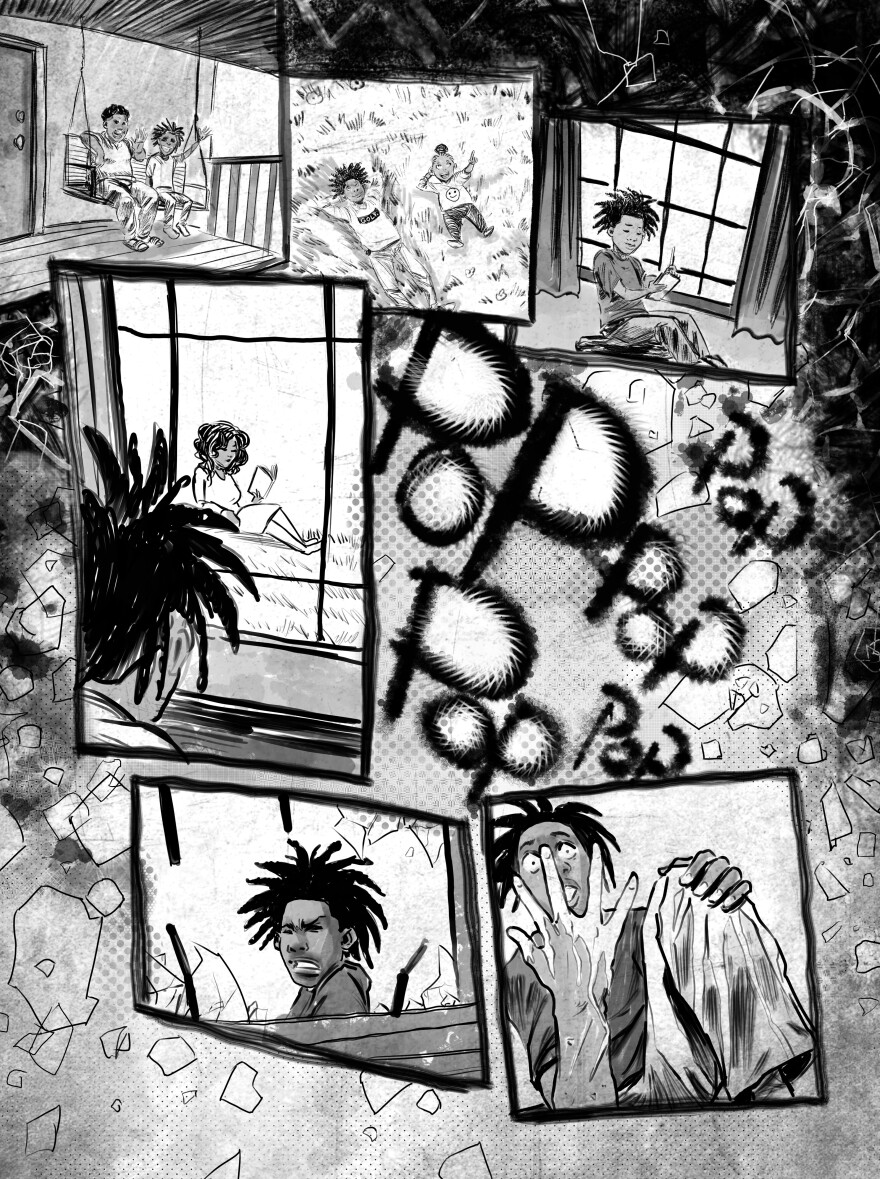The creative spark for drawing came to Alaska Native comic artist Dimi Macheras as a kid, growing up in the Chickaloon Native Village, in the Matanuska-Susitna Borough, and listening to his grandmother’s stories. He would illustrate the Ahtna legends she told him — like mischievous Raven lazing on a couch — and she encouraged it.
“Grandma shared her stories with me and collaborated with me to illustrate them and kind of gave me the permission to do that,” Macheras said. “And to be creatively free with how I chose to depict them, which is like comic books, or manga.”
Later in his twenties, with the support of his mother and grandmother, he illustrated and designed tribal language education and children’s comics which were adapted into Chickaloon school curriculum. He went on to launch the comic book studio, 80% Studios with creative partner Casey Silver. When the pandemic hit, they started the creation of the comic “Chickaloonies,” which follows two Alaska Native characters on an epic quest to become the greatest storytellers ever.
“It was one of those things where we can sit here and watch everything on Netflix or we can make a book, you know, we can do something,” Silver said.
The team behind “Chickaloonies” is part of the Łuk’ae Tse’ Taas or Fish Head Soup collective of Alaska Native comic artists and writers, which aims to share visual stories of Alaska’s rich regional cultures. The comic collective is in-residence at the Bunnell Street Arts Center in Homer for March.
On March 4, members came together for their first ever in-person panel to share about their creative work and the new collective.

“Our characters in the comic, Mister Yelly and Sasquatch E. Emoji, are thinly based on us. I talk a lot and Dimi draws pictures,” Silver said with a laugh. “But those two things combined, words and pictures, is our medium, is our art. And, it's been cool to have a thing where art imitates life, and life imitates art, and we're not quite sure where one began and ended. And personally, creatively for me, it's something I've always wanted.”
The “Chickaloonies” comic morphed into a live interactive workshop Macheras and Silver bring to schools and communities around Alaska, including one recently offered at the Homer Public Library. It shares Alaska Native storytelling, comic drawing and expression, around themes of sharing culture and Native values, and has drawn people of all ages.

“We found out the comic was almost secondary. What it was was the experience we had and the stories we were sharing,” Silver said.
Melissa Shaginoff is Ahtna and Piutte from the Chickaloon Native Village, and also a cousin of Macheras. She was also a cultural knowledge contributor to the “Chickaloonies” comic.
“I do a lot of things," she said. "I say that visiting is my art practice, meaning I just like to talk with people.”
Shaginoff is an artist, curator and activist, whose work is shaped by relationships and ceremonial systems. And she says sharing stories and visual storytelling is also an open invitation for others to find their own stories.
“When you say that you're Indigenous-centered, it's actually, the center is the inclusion,” Shaginoff said. “Because being Indigenous, it connects you to a sort of a higher system, a system that's connected to many different cultures. And so trying to use that as this way to invite people in, and to look at things from a different perspective, or from your own perspective.”

Richard Perry is Yup’ik and Gwich’in, and a writer, journalist, photographer and contributor to the Fish Head Soup collective. After growing up in Kentucky, he said returning to Alaska was a return to his Native heritage.
“At the time, there was no 'Molly of Denali,'” he said. “There were so few voices or faces in the media with Alaska Native people or children. And that is such a vital part of growing up and having a good sense of identity is to see and hear your voice in the media, in your community — whether it's out in the villages, or here near Anchorage, or wherever you're at. And that sense of community can be derived from hearing and telling stories, and that's been kind of my core drive.”
The Fish Head Soup collective is also about friendship and supporting each other, says comic artist Nathan Shafer. He’s a writer and special education teacher based in Anchorage, and author of the “Wintermoot” series, an Alaskan science fiction adventure story.
“Through those relationships is a way we collaborate with our communities too,” Shafer said. “It’s about building relationships that are sustainable, purposeful, and also authentic."
David Brame is an Afrofuturist artist and scholar, and also currently exhibiting at the Bunnell Street Arts Center in Homer.
“I also do conceptual Afro-surreal work,” he said. “And I’m ready to make work with these guys and really connect with, just like how Indigenous futurism and Afrofuturism have these really intimate linkages, and explore those.”
The name of the comic collective — Łuk’ae Tse’ Taas’ or Fish Head Soup — represents the members coming together like a nourishing soup, coming from the Ahtna tradition and Shaginoff’s language work with Chickaloon village elders.
Members of the collective are involved in drawing, writing, making poetry, designing comic book sequels, engaging in cultural and language work, and planning upcoming shows, including at the Anchorage Museum later this year.
You can follow the collective at fishheadsoupcomics.com, and check your local library for the “Chickaloonies” and “Wintermoot” comic books. In Homer, they’re available at the Homer Public Library or at the Bunnell Street Arts Center.


